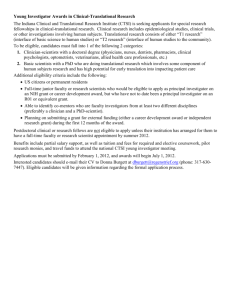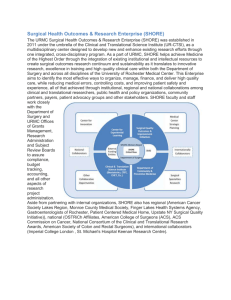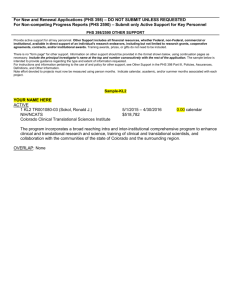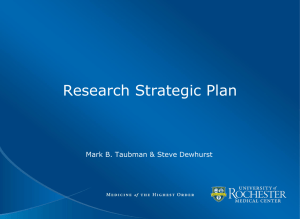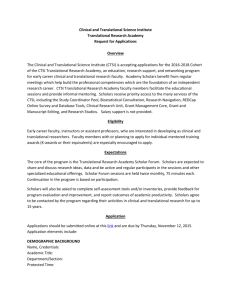PHS 398 (Rev. 11/07), Continuation Page
advertisement
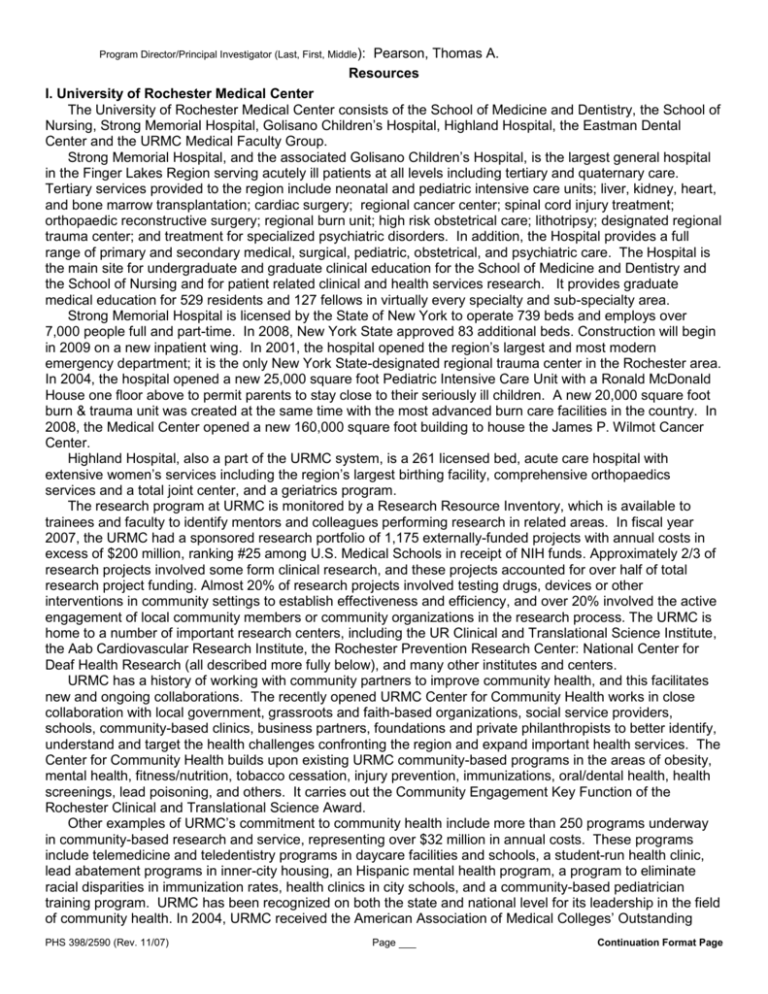
Program Director/Principal Investigator (Last, First, Middle): Pearson, Thomas A. Resources I. University of Rochester Medical Center The University of Rochester Medical Center consists of the School of Medicine and Dentistry, the School of Nursing, Strong Memorial Hospital, Golisano Children’s Hospital, Highland Hospital, the Eastman Dental Center and the URMC Medical Faculty Group. Strong Memorial Hospital, and the associated Golisano Children’s Hospital, is the largest general hospital in the Finger Lakes Region serving acutely ill patients at all levels including tertiary and quaternary care. Tertiary services provided to the region include neonatal and pediatric intensive care units; liver, kidney, heart, and bone marrow transplantation; cardiac surgery; regional cancer center; spinal cord injury treatment; orthopaedic reconstructive surgery; regional burn unit; high risk obstetrical care; lithotripsy; designated regional trauma center; and treatment for specialized psychiatric disorders. In addition, the Hospital provides a full range of primary and secondary medical, surgical, pediatric, obstetrical, and psychiatric care. The Hospital is the main site for undergraduate and graduate clinical education for the School of Medicine and Dentistry and the School of Nursing and for patient related clinical and health services research. It provides graduate medical education for 529 residents and 127 fellows in virtually every specialty and sub-specialty area. Strong Memorial Hospital is licensed by the State of New York to operate 739 beds and employs over 7,000 people full and part-time. In 2008, New York State approved 83 additional beds. Construction will begin in 2009 on a new inpatient wing. In 2001, the hospital opened the region’s largest and most modern emergency department; it is the only New York State-designated regional trauma center in the Rochester area. In 2004, the hospital opened a new 25,000 square foot Pediatric Intensive Care Unit with a Ronald McDonald House one floor above to permit parents to stay close to their seriously ill children. A new 20,000 square foot burn & trauma unit was created at the same time with the most advanced burn care facilities in the country. In 2008, the Medical Center opened a new 160,000 square foot building to house the James P. Wilmot Cancer Center. Highland Hospital, also a part of the URMC system, is a 261 licensed bed, acute care hospital with extensive women’s services including the region’s largest birthing facility, comprehensive orthopaedics services and a total joint center, and a geriatrics program. The research program at URMC is monitored by a Research Resource Inventory, which is available to trainees and faculty to identify mentors and colleagues performing research in related areas. In fiscal year 2007, the URMC had a sponsored research portfolio of 1,175 externally-funded projects with annual costs in excess of $200 million, ranking #25 among U.S. Medical Schools in receipt of NIH funds. Approximately 2/3 of research projects involved some form clinical research, and these projects accounted for over half of total research project funding. Almost 20% of research projects involved testing drugs, devices or other interventions in community settings to establish effectiveness and efficiency, and over 20% involved the active engagement of local community members or community organizations in the research process. The URMC is home to a number of important research centers, including the UR Clinical and Translational Science Institute, the Aab Cardiovascular Research Institute, the Rochester Prevention Research Center: National Center for Deaf Health Research (all described more fully below), and many other institutes and centers. URMC has a history of working with community partners to improve community health, and this facilitates new and ongoing collaborations. The recently opened URMC Center for Community Health works in close collaboration with local government, grassroots and faith-based organizations, social service providers, schools, community-based clinics, business partners, foundations and private philanthropists to better identify, understand and target the health challenges confronting the region and expand important health services. The Center for Community Health builds upon existing URMC community-based programs in the areas of obesity, mental health, fitness/nutrition, tobacco cessation, injury prevention, immunizations, oral/dental health, health screenings, lead poisoning, and others. It carries out the Community Engagement Key Function of the Rochester Clinical and Translational Science Award. Other examples of URMC’s commitment to community health include more than 250 programs underway in community-based research and service, representing over $32 million in annual costs. These programs include telemedicine and teledentistry programs in daycare facilities and schools, a student-run health clinic, lead abatement programs in inner-city housing, an Hispanic mental health program, a program to eliminate racial disparities in immunization rates, health clinics in city schools, and a community-based pediatrician training program. URMC has been recognized on both the state and national level for its leadership in the field of community health. In 2004, URMC received the American Association of Medical Colleges’ Outstanding PHS 398/2590 (Rev. 11/07) Page Continuation Format Page Program Director/Principal Investigator (Last, First, Middle): Pearson, Thomas A. Resources Community Service Award. Last year the church-based Healthy Living Program received the Innovation in Prevention Award from the US Department of Health & Human Services, and the Eastman Dental Center’s mobile dental clinic was awarded the Healthcare Association of New York State’s Community Health Improvement Award. II. Department of Community and Preventive Medicine The Department of Community and Preventive Medicine is an integral part of the University of Rochester School of Medicine and Dentistry. The environment provides a "real world" setting rich with research opportunities. Maximum contact with clinicians is available, as is access to data from the University's own affiliated health care delivery system. The national reputation of the University of Rochester coupled with its relatively small size and its emphasis on research allow for collaborative efforts among its many schools. The Department of Community and Preventive Medicine has strong relationships with other departments throughout the Medical Center as well as with the Eastman Dental Center, the School of Nursing, and the Simon School of Business. These relationships provide strength and diversity to the training and research activities of the Department. Five degree programs are offered by the Department: a Masters Degree in Public Health, a Master of Science in Clinical Investigation, a Master of Science in Translational Research, a PhD in Health Services Research and Policy, and a PhD in Epidemiology. The department also is home to an ACGME- and ACPMaccredited residency program in Preventive Medicine, and an NIH-supported postdoctoral research training program in Preventive Cardiology. In addition, several of the department’s PhD students are medical students in the joint MD/PhD program. The PhD program in Health Services Research and Policy is supported in part by a federal training grant from the Agency for Health Care Research and Quality. The Department of Community and Preventive Medicine serves as the focus for research activities relevant to population health at the University of Rochester School of Medicine and Dentistry. Usually, these have included behavioral sciences, epidemiology, and health services research. However, in conjunction with these core disciplines, a wide range of the social sciences are represented in faculty research interests, including economics, history, policy, ethics, nutrition, sociology, and anthropology. This fosters the Department's role as linkage to the undergraduate campus in many of these disciplines. Mission Statement. The mission of the Department of Community and Preventive Medicine is to improve the health and the understanding of the health of populations locally, nationally, and internationally both through research and by training outstanding researchers, educators, administrators, policy makers, clinicians, and practitioners. Educational Mission. The Department’s overall educational mission is to contribute to relevant programs at all levels of the institution including undergraduate, baccalaureate, Master’s, MD, Ph.D. and post-doctoral training. Research Mission. In research, using various theoretical approaches and fields of study, as well as multidisciplinary collaborations, the Department pursues basic and applied knowledge about clinical medicine, health services and policy, epidemiology, and social and behavioral medicine. Community Service Mission. The Department will provide leadership and support for local community public health programs and initiatives and, as well, contribute in similar capacities regionally, nationally and internationally. The Department provides essential computing infrastructure for the Preventive Cardiology Research Training Program. Dan McCarthy, Information Systems Coordinator for the Department, ensures data and network security for the department, manages departmental servers for shared file storage and research applications, provides ongoing maintenance and software installation services for departmental PCs, and provides purchasing support for new machines. All shared data is backed up on a daily basis. Weekly and monthly backup data is stored offsite. Statistical software packages, include SAS, SPSS, Stata and SUDAAN, are available on departmental research servers. The Research Services Group (RSG), based in the Department, provides support to clinical and academic researchers, and community and governmental agencies. The RSG staff (including PhD and MS prepared individuals) has experience in database management (Epi-Info and ACCESS), SAS programming and statistical analysis, data entry, cleaning and coding, survey management and interviewing. Their work encompasses qualitative data collection, including key informant interviews and focus groups. Recent PHS 398/2590 (Rev. 11/07) Page Continuation Format Page Program Director/Principal Investigator (Last, First, Middle): Pearson, Thomas A. Resources qualitative work has ranged from formative research using interviews and focus groups for Monroe County on perceptions about child abuse/reporting, dental health and insurance issues among the chronically ill elderly, parenting practices (use of timeout, discipline) and views of participants at a federally funded inner city health/human services center. Additional work includes survey design and development, research subject recruitment, medical chart abstraction and database development and management. Their survey work includes both mailed and telephone surveys. Recent survey projects include: national mailed survey of Pediatric/Family Medicine Physicians about a proposed nasal flu vaccine for young children; Smoking Cessation longitudinal follow-up telephone calls; State-wide telephone survey about Child Health Plus; telephone follow-up to parents of children participating in an asthma intervention study; two telephone surveys about child abuse, parenting and shaken baby syndrome, a survey of nursing home administrators and a national mailed survey to PACE program employees. All RSG supported projects are planned closely with the project’s Principal Investigator to ensure quality results. The Department hosts Public Health Grand Rounds, a series of biweekly seminars open to the Medical Center and general public that explores the complex world of modern public health. Recent topics have included the URMC’s Center for Community Health, building a community coalition for children’s emergency medicine, tobacco cessation intervention research in the Dominican Republic, integrating public health and primary care in rural Haiti, a community/hospital partnership to prevent youth violence, and the Genetic Information Nondiscrimination Act (GINA). III. Clinical and Translational Science Institute The University of Rochester Clinical and Translational Science Institute (UR CTSI) is the academic home for clinical and translational science at the institution, providing a centralized, integrated infrastructure. It is supported in part by a Clinical and Translational Science Award from the NIH. The UR was one of the first 12 institutions to earn an award under this program. Under a novel system of governance, the Dean of the School of Medicine and Dentistry, David S. Guzick MD PhD, also serves as the CTSA Principal Investigator, and therefore has authority over space, faculty, budgets, and other resources related to the CTSI, including the Clinical Research Center (CRC). Thomas A. Pearson, MD MPH PhD, Program Director for the Figure 1: UR CTSI organizational chart Preventive Cardiology Training grant, CTSA Principal Investigator and Dean serves as Co-Principal Investigator CTSI Director and Senior Associate Dean for Clinical Research for the program and Director of the CTSI (See Figure 1, CTSI Organizational Chart). CTSI Administrative Core CTSI Executive Committee With these newly-integrated resources, the UR will transform the two distinct research fields of clinical and translational science into a single Committee on External Advisory Industry and new discipline. The goals of this Committee Foundation CTSI Administrative Committee discipline include the creation of new Relations knowledge and techniques to diagnose, prevent and treat human CTSI Key Functions disease, and the establishment of an Education, Training, Study Design Clinical Research Novel Upstate New York Career Dev Support Center environment that catalyzes their Methodologies Translational Research Network application to clinical practice in the Community Biomedical Translational community. The UR CTSI will carry Pilot Studies Regulatory Support Engagement Informatics Technologies out a number of specific aims involving the development of novel clinical and translational research Evaluation Working Group methodologies; support for pilot studies; upgraded biomedical informatics, epidemiology, research design, ethics, and regulatory support; community engagement; new technology and resource cores; new educational and training programs; an Upstate New York Consortium for translational research; and rigorous evaluation and measurement of performance outcomes. PHS 398/2590 (Rev. 11/07) Page Continuation Format Page Program Director/Principal Investigator (Last, First, Middle): Pearson, Thomas A. Resources The UR CTSI makes available a wide array of resources for predoctoral and postdoctoral trainees in preventive cardiology. The trainee can request assistance without charge from at least seven clinical/translational research consultation services, including: Bioinformatics, Biostatistics, Community Engagement, Epidemiology, Ethics/Conflict of Interest, Regulatory Support, and Research Subject Recruitment and Retention. A single point of entry introduces the trainee with a Research Navigator who can help them find the most appropriate assistance. Trainees are eligible to apply from five different internal funding programs: Pilot Studies, Novel Technology Development, General Clinical Research Center Pilot Studies, Pilot Studies within the Upstate NY Translational Science Network, and Laboratory Support Grants (for specific assays in blood, urine, etc.). A number of core research facilities are also available to trainees, including a Clinical Research Support Laboratory, a Clinical Trials Coordinating Center, the GCRC, and a Practice-based Research Network. All postdoctoral fellows are designated as “CTSI Scholars.” The Education, Training, and Career Development Key Function of the CTSA supports the MS-TR, MS-CI, and MPH Program that most postdoctoral trainees complete. It also supports several Skill-building Workshops, such as Practical Skills in Grant Writing as well as the weekly Clinical and Translational Research Seminar Series. Finally, the Career Development Program of the CTSA is an integral part of the mentoring of each trainee as well as the means to evaluate the trainee’s progress. IV. Clinical and Translational Science Building Planning is nearly complete for a new 200,000 sq. ft. Clinical and Translational Science Building (CTSB) in which faculty conducting clinical and translational research will work alongside students and trainees in existing and new degree-granting programs. Groundbreaking took place in October 2008, with construction slated to begin in February 2009. Also within the building will be supporting regulatory and administrative functions, and faculty working in collaborative disciplines such as biostatistics, epidemiology, and biomedical informatics. The Preventive Cardiology Research Training program will be located in the CTSB in the quarters occupied by the Department of Community and Preventive Medicine (Figure 2). The Director of the UR CTSI will integrate the clinical and translational science functions contained in the CTSB with those functions located at other campus locations, such as functional genomics, other translational resources, and the CRC. A noteworthy example of the deepening integration of the research infrastructure at the institution is the recent move of the CRC into a newly-renovated 10,500 sq ft facility across the street from the future location of the CTSB, with enhanced functionality and street-level access for volunteer subjects. As well, the UR CTSI will create two-way synergies with local community groups (school system, faith community, business, foundations) and with other Upstate New York institutions. Further, the UR CTSI will enable the sharing of data across disciplines and across institutions while assuring the privacy and confidentiality of human subjects. Clinical Research Center: Of particular relevance to this application is the Clinical Research Center (CRC). The CRC was one of the oldest General Clinical Research Centers funded by the NIH, with continuous funding since the 1960s. It is now a component of the CTSI. The CRC provides the ideal environment for patient-oriented studies. First, it provides space, skilled nursing and bionutrition staff, and other laboratory services. Second, the CRC fosters collaboration between clinical, translational and basic science investigators by making information on ongoing studies available through a web-based inventory and through the efforts of a new Associate CRC Program Director. Third, the CRC expedites protocol initiation through specific training programs, dedicated staff assistance, and the co-location of administrative support functions in the CRC. Fourth, the CRC encourages and facilitates participation of volunteer subjects through its new, accessible location (a short walk from the future site of the CTSB), providing financial support for subject travel expenses, and providing child care services in the CRC. Fifth, the CRC maintains a cadre of skilled research coordinators and coordinates their availability to URMC investigators on a cost-sharing basis. Finally, the CRC will promote the introduction of novel research techniques for patient-oriented studies through ongoing seminars. This constellation of accessible support services in a dedicated environment ensures that investigators overcome the challenges attendant to clinical and translational patient-oriented research. The CRC currently occupies newly renovated space encompassing 10,495 square feet in new quarters near the CTSB. It includes an outpatient unit consisting of 4 beds and an outpatient area with 8 rooms to support outpatient procedures/studies, employs 7.34 full time equivalents (FTEs) research nurses, a PhD level nutritionist and dietitian (1.87 FTE), a Clinical Research Coordinator and a Child Life Specialist (.5 FTE). PHS 398/2590 (Rev. 11/07) Page Continuation Format Page Program Director/Principal Investigator (Last, First, Middle): Pearson, Thomas A. Resources Figure 2. Second Floor of New CTSB, Home for Preventive Cardiology Training Program. V. Information Systems The medical center has an extensive variety of information technology deployed in support of its research, education and patient care missions. Two data center operations facilities support 24/7 systems operations, high availability and rapid recovery in the event of a system or facility disaster. Within the data centers there are 350 terabytes of disk storage, redundant arrays of disk storage supporting remote data replication, a 2 Gb fibre channel SAN fabric, enterprise tape-based backup and recovery systems and a 1 Gb network backbone. Connectivity to the internet is supplied through multiple OC3 connections supplied by diverse providers. Additionally, the university is a member of the Internet2 consortium and is currently developing connectivity for the National Lambda Rail research network. The Medical Center’s network infrastructure has recently been upgraded to a 10Gb/s wired-network infrastructure. A wireless network infrastructure covers the entire 5 million+ square foot facility. A new data center project has been approved that will construct a modern and highly reliable facility with N+1 redundancy and large scale power and cooling capabilities. This new facility will enable the acquisition of larger-scale, high performance computing infrastructure which currently cannot be installed due to infrastructure limitations. The URMC Web Development Group provides the URMC community with no-cost access to high storage capacity and high throughput web servers. These servers are capable of hosting virtually unlimited video content, as well as the usual text and image content common to all websites. The Web Development Group also provides access to and training for Contribute software, which is used to maintain website content and PHS 398/2590 (Rev. 11/07) Page Continuation Format Page Program Director/Principal Investigator (Last, First, Middle): Pearson, Thomas A. Resources links via a WYSIWYG interface, without the need to know html programming. URMC users have access to the system and training at no cost. UR Information Technology Services provides access to and support for Listserv 15.5 software, a wellknown and powerful e-mail list management software package. The system’s web interface allows for easy management of multiple e-mail lists. All outgoing messages are automatically screened for computer viruses. The system supports all types of e-mail lists, including announcement lists and both moderated and unmoderated discussion groups. Users may subscribe or unsubscribe to lists through the web interface. Message archives are also available through the web interface. VI. URMC Libraries The University of Rochester library system is one of the top academic research libraries in the United States and Canada. Holdings exceed 3.5 million volumes, and include extensive collections of online databases, electronic journals, rare books, and musical scores. The Edward G. Miner Library provides resources on all aspects of medicine and nursing. It is located at the Medical Center and maintains a state-ofthe-art presence on the web. Miner provides access to nearly 300 health-related e-books and over 14,000 electronic journals. Print collections include more than 240,000 volumes of journals, books, and theses plus current subscriptions to nearly 1,000 print journals. Print and electronic books, journals, and theses are cataloged on the University of Rochester’s online catalog. Miner Library’s website provides access to indexes of the scientific literature including PubMed, Ovid Medline, PsycInfo and the Web of Science. Miner provides many other online information services, including InfoPOEMS/InfoRetriever, Up-to-Date, Cochrane databases, and other evidence-based resources. The library provides access to a huge and ever-expanding pool of resources through the inter-library loan system. PHS 398/2590 (Rev. 11/07) Page Continuation Format Page
